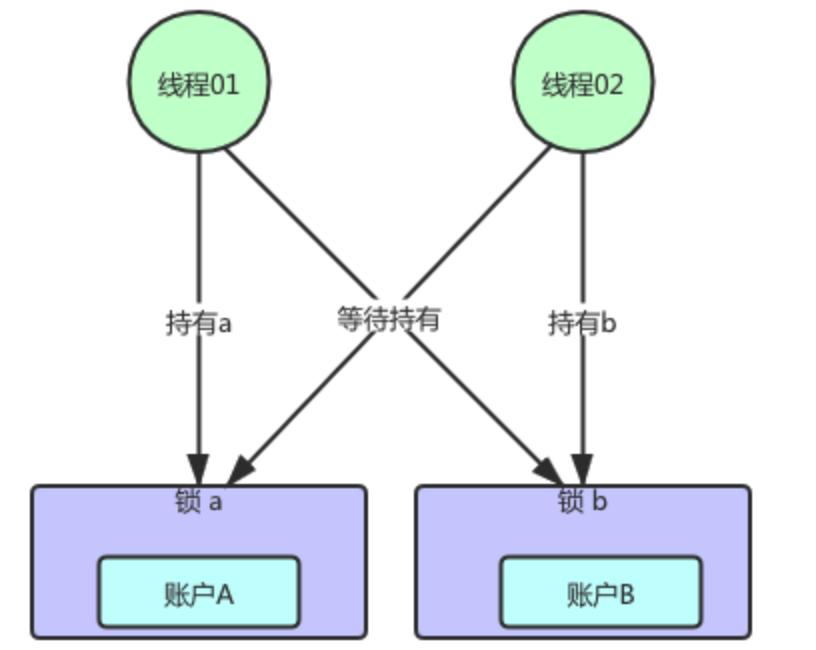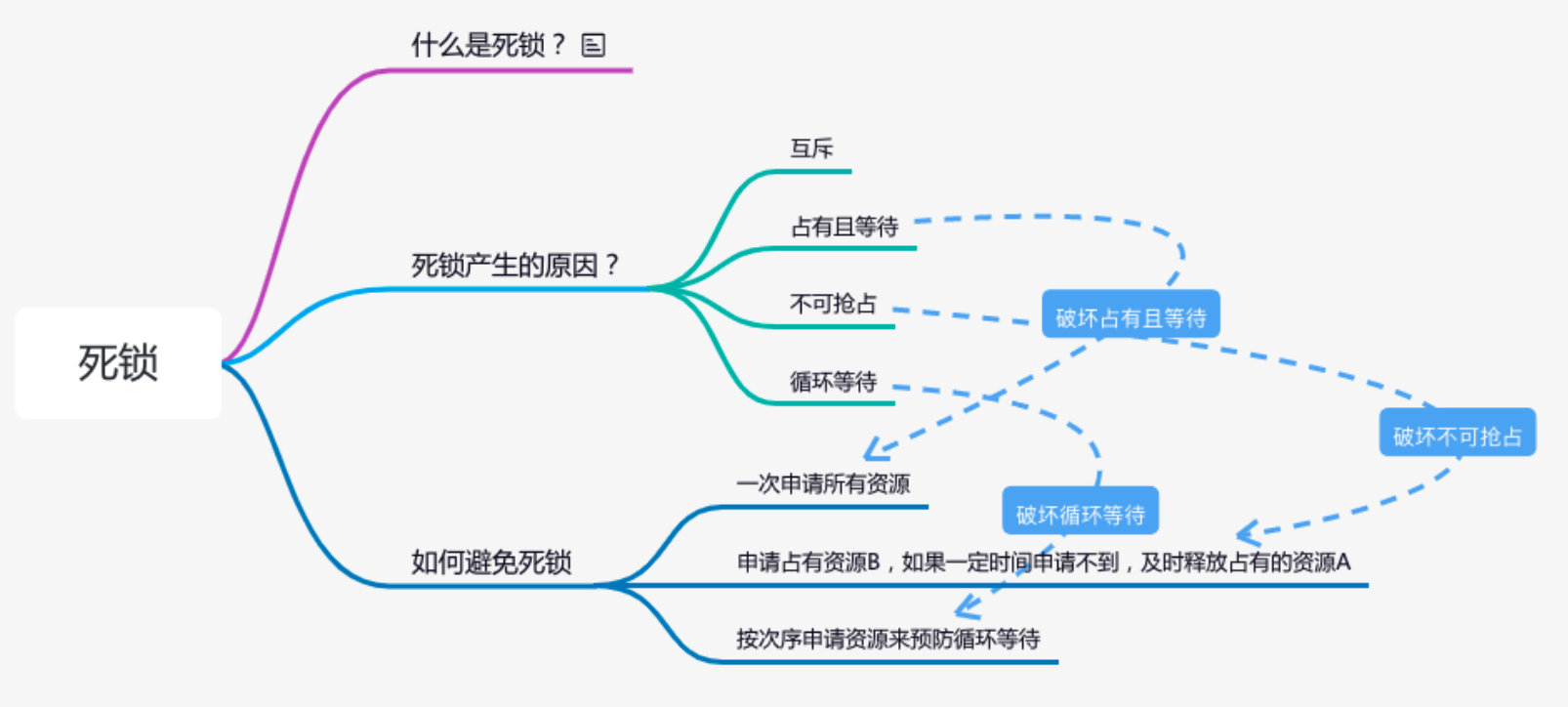1. 死锁产生
1.1. 问题描述
在互联网的交易系统中,出现这种场景:【账户A】转账给【账户B】,同时【账户B】也转账给【账户A】,两个账户都需要锁住余额,所以通常会申请两把锁。转账时,先锁住自己的账户,并获取对方的锁,保证同一时刻只能由一个线程去执行转账。
这时可能就会出现,对方给我转账,同时我也给对方转账,那么双方都持有自己的锁,且尝试去获取对方的锁,这就造成可能一直申请不到对方的锁,循环等待发生『死锁』问题
1.2. 死锁示例
死锁是两个或两个以上的线程在执行过程中,互相持有对方所需要的资源,导致这些线程处于等待状态,无法继续执行。
public class DeadLock {public static String obj1 = "obj1";public static String obj2 = "obj2";public static void main(String[] args) {Thread a = new Thread(new Lock1());Thread b = new Thread(new Lock2());a.start();b.start();}}class Lock1 implements Runnable {@Overridepublic void run() {try {System.out.println("Lock1 running");while (true) {synchronized (DeadLock.obj1) {System.out.println("Lock1 lock obj1");Thread.sleep(3000);synchronized (DeadLock.obj2) {System.out.println("Lock1 lock obj2");}}}} catch (Exception e) {e.printStackTrace();}}}class Lock2 implements Runnable {@Overridepublic void run() {try {System.out.println("Lock2 running");while (true) {synchronized (DeadLock.obj2) {System.out.println("Lock2 lock obj2");Thread.sleep(3000);synchronized (DeadLock.obj1) {System.out.println("Lock2 lock obj1");}}}} catch (Exception e) {e.printStackTrace();}}}
1.3. 死锁产生的原因
虽然进程在运行过程中,可能发生死锁,但死锁的发生也必须具备一定的条件,死锁的发生必须具备以下四个必要条件:
- 互斥,共享资源 X 和 Y 只能被一个线程占用;
- 占有且等待,线程01 已经取得共享资源 X,在等待共享资源 Y 的时候,不释放共享资源 X;
- 不可抢占,其他线程不能强行抢占线程01 占有的资源;
- 循环等待,线程01 等待线程02 占有的资源,线程02 等待线程01 占有的资源,就是循环等待。
2. 如何避免死锁
- 首先,“互斥”是没有办法避免的,对于“占用且等待”这个条件,我们可以一次性申请所有的资源,这样就不存在等待了。
- 对于“不可抢占”这个条件,占用部分资源的线程进一步申请其他资源时,如果申请不到,可以在一定时间后,主动释放它占有的资源,这样就解决了不可抢占这个条件。
- 对于“循环等待”,我们可以靠按“次序”申请资源来预防。所谓按序申请,就是给资源设定顺序,申请的时候可以先申请序号小的资源,再申请序号大的,这样资源线性化后,自然就不存在循环等待了。
2.1 破坏占用且等待条件
我们要破坏占用且等待,就是一次性申请占有所有的资源,我们拿文章开头的【账户A】、【账户B】来举例,就是一次性申请账户A,账户B的锁,当线程 01 拿到账户 A、B 全部的锁后,再执行具体的操作。
Allocator.java
/*** 分配器*/public class Allocator {private List<Object> als = new ArrayList<>();/*** 一次性申请所有资源** @param from* @param to* @return*/synchronized boolean apply(Object from, Object to) {if (als.contains(from) || als.contains(to)) {return false;} else {als.add(from);als.add(to);}return true;}synchronized void clean(Object from, Object to) {als.remove(from);als.remove(to);}private void Allocator() {}private static class SingleTonHolder {private static Allocator INSTANCE = new Allocator();}public static Allocator getInstance() {return SingleTonHolder.INSTANCE;}}
Account.java
/*** 账户*/public class Account {private Allocator actr = Allocator.getInstance();private int balance;/*** 转账** @param target 目标账户* @param amt 转账金额*/void transfer(Account target, int amt) {while (!actr.apply(this, target)) {}try {synchronized (this) {System.out.println(this.toString() + " lock obj1");synchronized (target) {System.out.println(this.toString() + " lock obj2");if (this.balance > amt) {this.balance -= amt;target.balance += amt;}}}} finally {//执行完后,再释放持有的资源actr.clean(this, target);}}}
main
public class DeadLock {public static void main(String[] args) {Account a = new Account();Account b = new Account();a.transfer(b, 100);b.transfer(a, 200);}}
2.2 破坏不可抢占条件
破坏不抢占条件,需要发生死锁的线程能够主动释放它占有的资源,但使用 synchronized 是做不到的。原因为 synchronized 申请不到资源时,线程直接进入了阻塞状态,而线程进入了阻塞状态也就没有办法释放它占有的资源了。
不过 JDK 中的 java.util.concurrent 提供了 Lock 解决这个问题。
显式使用 Lock 类中的定时 tryLock 功能来代替内置锁机制,可以检测死锁和从死锁中恢复过来。使用内置锁的线程获取不到锁会被阻塞,而显式锁可以指定一个超时时限(Timeout),在等待超过该时间后 tryLock 就会返回一个失败信息,也会释放其拥有的资源。
public class DeadLock {public static ReentrantLock lock1 = new ReentrantLock();public static ReentrantLock lock2 = new ReentrantLock();public static void main(String[] args) {Thread a = new Thread(new Lock1());Thread b = new Thread(new Lock2());a.start();b.start();}static class Lock1 implements Runnable {@Overridepublic void run() {try {System.out.println("Lock1 running");while (true) {if (lock1.tryLock(1, TimeUnit.MILLISECONDS)) {System.out.println("Lock1 lock obj1");//Thread.sleep(3000);if (lock2.tryLock(1, TimeUnit.MILLISECONDS)) {System.out.println("Lock1 lock obj2");}}}} catch (Exception e) {e.printStackTrace();} finally {lock1.unlock();lock2.unlock();}}}}
2.3 破坏循环等待条件
破坏这个条件,只需要对系统中的资源进行统一编号,进程可在任何时刻提出资源申请,必须按照资源的编号顺序提出。这样做就能保证系统不出现死锁。这就是『资源有序分配法』。
class Account {private int id;private int balance;void transfer(Account target, int amt){Account left = this;Account right = target;if (this.id > target.id) {left = target;right = this;}synchronized(left){synchronized(right){if (this.balance > amt){this.balance -= amt;target.balance += amt;}}}}}
3. 死锁总结
4. 基于 Guarded Suspension 模式,优化百万交易系统
4.1 Guarded Suspension 模式简介
guarded 在这里是“保护”的意思;suspension 在这里是“暂时挂起”的意思。所以,Guarded Suspension 模式又称为“保护性暂挂模式”;
在多线程开发中,常常为了提高应用程序的并发性,会将一个任务分解为多个子任务交给多个线程并行执行,而多个线程之间相互协作时,仍然会存在一个线程需要等待另外的线程完成后继续下一步操作。而 Guarded Suspension 模式可以帮助我们解决上述的等待问题。
还是用交易系统的“转账”场景来讲述这个模式的实现。在上一篇文章中,我们提到,【账户A】转账给【账户B】,线程01需要持有账户A的锁,同时也需要持有账户B的锁,如果线程01拿不到两个锁,则进行 while(!actr.apply(this, target)) 死循环的方式来循环等待,直到一次全部获取到两个锁后,才进行后面的转账操作。
在并发量不大的情况下,这种方案还是可以接受的,但是一旦并发量增大,获取锁的冲突增加的时候,这种方案就不适合了,因为在这种场景下,可能要循环上万次才能获得锁,非常消耗性能,互联网高并发下显然不适合。
在这种场景下,最好的方案就是使用 Guarded Suspension 模式,如果线程 01 拿不到所有的锁,就阻塞自己,进入“等待WAITING”状态。当线程 01 要求的所有条件都满足后,“通知”等待状态的线程 01 重新执行。
4.2 代码举例
下面我们写一段代码来描述这段“等待-通知”机制:

1、 创建GuardedQueue类
public class GuardedQueue {private final Queue<Integer> sourceList;public GuardedQueue() {this.sourceList = new LinkedBlockingQueue<>();}public synchronized Integer get() {while (sourceList.isEmpty()) {try {wait(); // <--- 如果队列为null,等待} catch (InterruptedException e) {e.printStackTrace();}}return sourceList.peek();}public synchronized void put(Integer e) {sourceList.add(e);notifyAll(); //<--- 通知,继续执行 }}
2、测试一下
public class App {public static void main(String[] args) {GuardedQueue guardedQueue = new GuardedQueue();ExecutorService executorService = Executors.newFixedThreadPool(3);executorService.execute(() -> {guardedQueue.get();});Thread.sleep(2000);executorService.execute(() -> {guardedQueue.put(20);});executorService.shutdown();executorService.awaitTermination(30, TimeUnit.SECONDS);}}
4.3 总结与拓展
Guarded Suspension模式的“等待-通知”机制是一种非常普遍的线程间协作的方式。我们在平时工作中经常看到有同学使用“轮询 while(true)”的方式来等待某个状态,其实都可以用这个“等待-通知”机制来优化。
另外,有同学可能会问为什么不用 **notify()** 来实现通知机制呢?
Notify() 和 notifyAll() 这两者是有区别的,notify() 是会随机地通知等待队列中的任意一个线程,而 notifyAll() 会通知等待队列中的所有线程。
觉得 notify() 会更好一些的同学可能认为即便通知所有线程,也只有一个线程能够进入临界区。但是实际上使用 notify() 也很有风险,因为随机通知等待的线程,可能会导致某些线程永远不会被通知到。
所以除非经过深思熟虑,否则尽量使用 notifyAll()。


